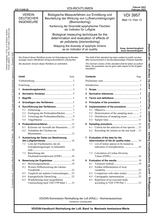Standards Worldwide
Standards Worldwide
Phone +49 30 58885700-07

Technical rule [CURRENT]
VDI 3957 Blatt 13:2023-02
Biological measuring techniques for the determination and evaluation of effects of air pollutants (biomonitoring) - Mapping the diversity of epiphytic lichens as an indicator of air quality
- German title
- Biologische Messverfahren zur Ermittlung und Beurteilung der Wirkung von Luftverunreinigungen (Biomonitoring) - Kartierung der Diversität epiphytischer Flechten als Indikator für Luftgüte
- Publication date
- 2023-02
- Original language
- German, English
- Pages
- 30
- Publication date
- 2023-02
- Original language
- German, English
- Pages
- 30
Product information on this site:
Quick delivery via download or delivery service
Buy securely with a credit card or pay upon receipt of invoice
All transactions are encrypted
Short description
The standard deals with the standardised recording of the diversity of lichens occurring on tree bark. The determined number of lichen species and their frequency are incorporated into diversity values, which can be used to draw conclusions about the air quality (here divided into five levels from "very high" to "very low" air quality) at the investigated site. The result integrates all factors affecting the lichens at the site. In addition to local climatic influences, these include in particular the effects of acidifying and eutrophying air pollutants and dusts. Standardised lichen mapping can be used in the vicinity of an emission source to identify its possible effects, or - on a regional scale - to reveal focal points of environmental pollution. Repeated surveys in the same study area allow the assessment of changes in the environment. The standard is intended for permit authorities and monitoring authorities and, in particular, executing operators such as environmental engineering firms. The previous version of the standard, already published in 2005, required revision, as the assessment matrix it contained no longer fully covered current pollution conditions.
Content
ICS
13.040.20
Replacement amendments
This document replaces VDI 3957 Blatt 13 Berichtigung:2007-02 , VDI 3957 Blatt 13:2005-12 .
Also available in
Loading recommended items...
Loading recommended items...
Loading recommended items...
Loading recommended items...
